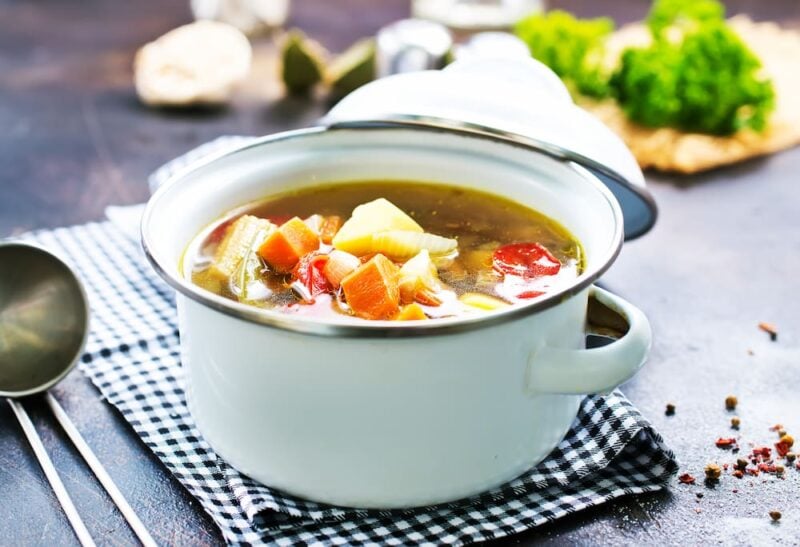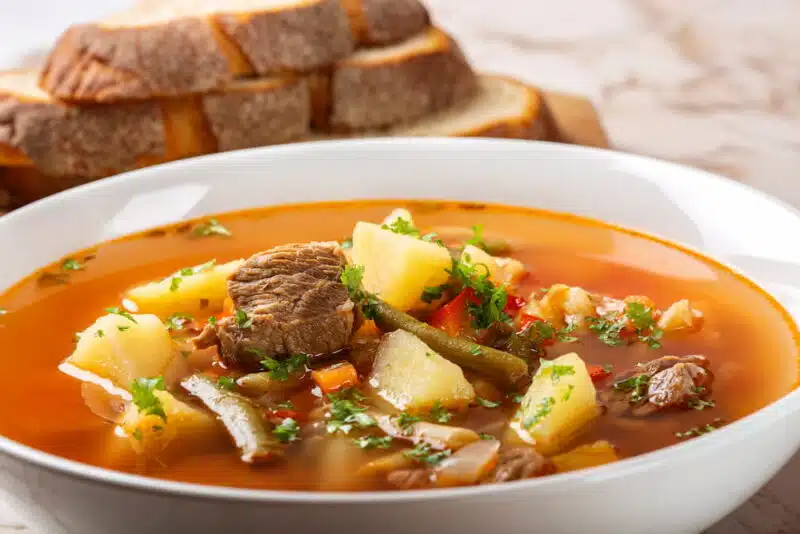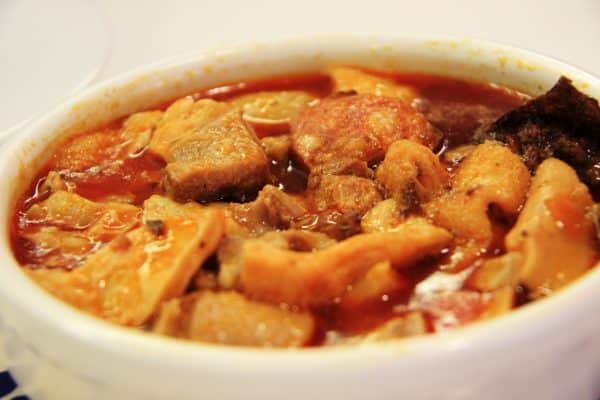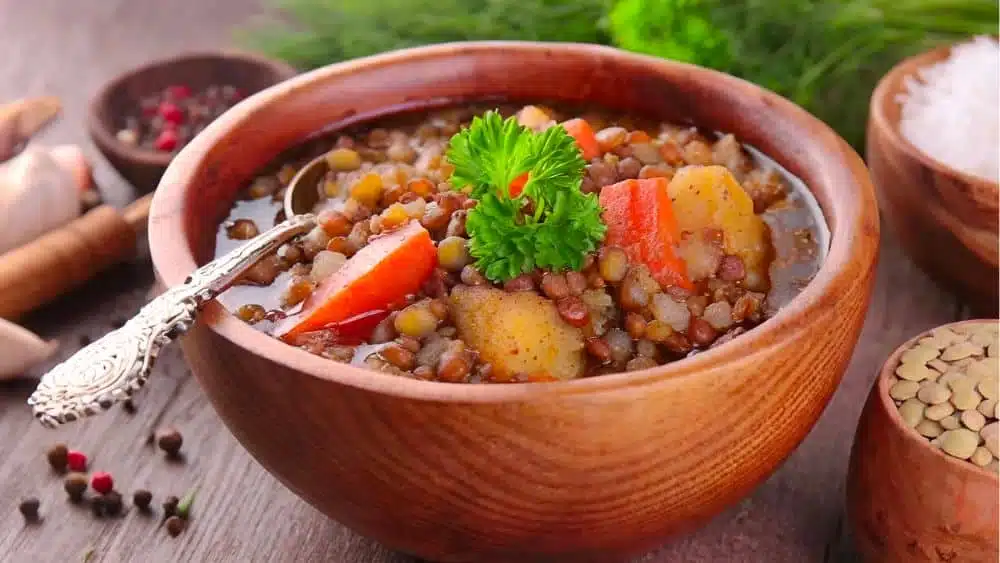Hello everyone! They are very welcome to Paulina cuisine and a free trip direct to the culture of Mexico , with one of its most traditional recipes: pot mole .
In addition to knowing a little about the history of this incredible mole dish, typical of Mexican cuisine, ideal for cold, we will learn to do it. We will review their secrets, and above all the techniques to handle their two main ingredients: flesh and Chile , so that it is an insured success.
Content table
About the pot of pot
The pot mole is a type of soup or broth. It can vary according to the region of Mexico and the tastes of each cook or diner. Some versions may include other types of chiles or spices, and vegetables can also vary according to availability and taste.
This dish is highly appreciated for its comforting flavor and its ability to combine a wide variety of ingredients harmoniously. It is an excellent example of the wealth and diversity of Mexican cuisine.
The pot of pot , is characterized by its rich and complex flavor , which combines different ingredients , including beef, vegetables and spices, including a mixture of spices that can include or set, thyme, laurel, cumin and pepper , among others.
- Other ingredients: garlic, onion and tomato that are basic for the base of the broth and the sauce.
As is the typical grandmother's pot mole
The grandmother's pot mole generation to generation and that can be adapted to the tastes of each family.
- In general, the grandmother's pot mole is very hot in bowls, making sure to include some meat and a good portion of vegetables on each dish. In addition, depending on each family, they are accompanied with rice, corn tortillas and a little lemon juice.
As a grandmother's advice, it comes to us that it is always welcome to add a special touch that makes it different. That is: an extra pinch of some kind, a fresh chili chopped at the time of serving, or even a piece of xoconostle (acidic fruit) to give a unique touch to the pot mole .
What are the ingredients that the pot mole carries
Among the main ingredients of this recipe are included:
- Vaca/res: Chambarete or Retazo with bone is generally used, which gives the broth a deep flavor.
- Vegetables: garlic, onion and tomato are basic for the base of the broth and the sauce. So also elotes /choclos, zucchini, carrots, chayote /potatoes of the air, ejotes /chauchas, potatoes and sometimes xoconostle .
- Chiles: Dry chiles such as Guajillo Chile and Pasilla Chile are usually used, which are touched and soaked to make a sauce that is added to the broth.
- Species: This recipe has a mixture of spices that can include oregano, thyme, laurel, cumin and pepper, among others.
Referred to by the popular saying "to give it that it is mole of pot"
The expression "to give it that it is pot of pot" is a popular phrase in Mexico that is used to motivate someone to start a task or activity with enthusiasm and energy.
The phrase compares the action of starting something with the preparation of this recipe. Since although time and effort requires , but this results in a very satisfying and delicious dish. Basically, it means that you have to get to work with determination, since the effort will be worth it , as well as prepare a good pot of pot .
A little history about the traditional pot of pot mole
This soup is a traditional Mexican dish with a rich history. It is believed that its origin is in the miscegenation of culinary cultures that occurred after the arrival of the Spaniards to Mexico.
- Pre -Hispanic Origins: Pre -Hispanic Mesoamerican cultures have already prepared stews with meat, vegetables and chiles, using ingredients such as corn, beans, pumpkin, chayote and chili.
These dishes were an important source of nutrition for indigenous populations and were consumed on special occasions and celebrations.
- Spanish influence: With the arrival of the Spaniards to Mexico, new ingredients such as beef, pork, chicken and sheep, and also spices such as cumin, coriander and oregano were introduced.
The Spaniards also brought with them the technique of cooking in pots, which allowed to prepare more substantial and complex stews.
About 4 of its variants:
- The most typical pot mole in the State of Mexico is the one that is made with: beef, pumpkin, ejote, pumpkin flower, corn and xoconostle, seasoned with epazote, onion, pump chiles, chilaca and wide.
- Green pot mole : with pork spine, green tomato, jalapeño and serrano chili, elote, zucchini, ejotes, chickpeas, epazote and pumpkin flower.
- In Hidalgo there are many versions , so much so that it is stated that practically each family has a different recipe of pot mole. Although it may seem a bit exaggerated.
- Among the most common is the pot mole with xoconostle, which carries beef, xoconostles in pieces, pumpkin and corn; The broth is seasoned with c hiles Guajillo, wide and stew , in addition to garlic and onion that are indispensable; It is aromatized with epazote and thick slightly with corn dough.
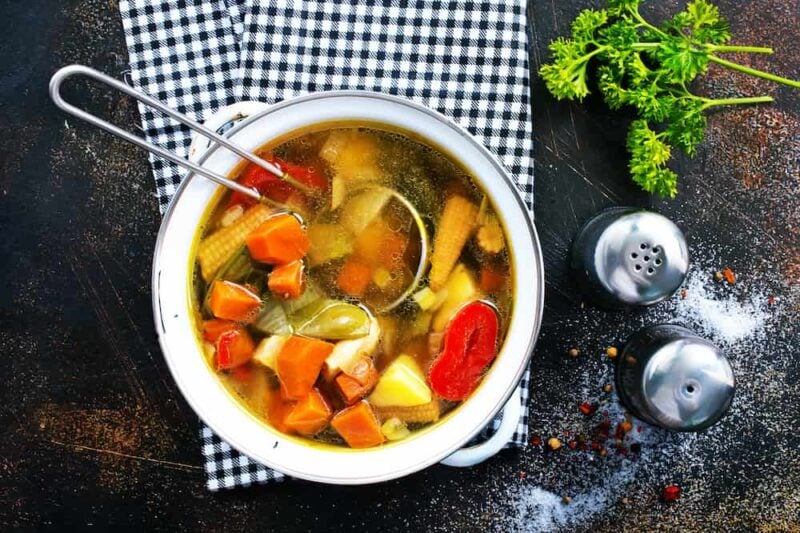
Olla mole vs. beef mole: main differences
- Salsa: The beef mole uses a thick and complex sauce typical of the mole, which carries chocolate among its main ingredients, while the pot mole has a lighter and lighter broth.
- Consistency : The beef mole is denser , while the pot mole is more similar to a stew or broth.
- Vegetables: The pot mole includes a variety of vegetables that are not common in the beef mole.
- Preparation: The beef mole is often cooked with the already prepared sauce , while the pot mole implies the cooking of the ingredients in the broth from the beginning.
Before starting with the pot mole recipe
At this point we saw that this soup has a significant presence in several regions of the country of Mexico. Even each region can have its own variations, and the ingredients and spices can be adapted according to local traditions and the availability of products.
It is very common to find this dish in the states of the center and southern Mexico, such as: Mexico City, State of Mexico, Morelos, Puebla, Tlaxcala, Guerrero and Michoacán.
Some suggestions:
- Accompanying with a rich home bread is my favorite way.
- To make sure you have enough pot mole for all, you can prepare in a larger pot twice the recipe or do it in two batches .
- To make it more yield, you can also serve the pot of pot with rice or tortillas to be more substantial.
- You can use different types of meat for the pot mole, such as skirt, chest or itsero.
- The pot mole can be saved and then reheat the next day, they say what they know is even more delicious.
Then a recipe that does not fail, the most traditional but with a special touch. This was dictated by a Guerrero grandmother but they say nothing? It is a secret.
Follow on Instagram ( here )
and on YouTube that I upload new videos every week ( click here )
Olla Mole Recipe
Yield: 6 portions
Preparation time: 2 hours
Ingredients:
- 1/2 kilo of beef (cecina or skirt)
- 4 pieces of chambarete with bone
- 1/4 kilo of zucchini
- 4 wide chiles
- 2 pump chiles
- 1/2 chopped onion
- 2 peeled potatoes and cubes
- 4 peeled and cut carrots
- 1/2 kilo of corn/choclos cut in half
- 8 cups of water/ 2 liters
- 2 tomatoes
- 2 chopped garlic cloves
- Others: Oil, salt and pepper
How to make homemade pot mole
- In a large pot with 3 tablespoons of oil, fry the beef (cecina or skirt) and the chambarete along with chopped garlic for 5-10 minutes until slightly brown.
- Cover meat with water and boil for 30-40 minutes or until the meat is cooked. Add the potatoes, carrots and corn. Continue cooking for 20 more minutes or until vegetables are tender.
- Roast the wide and stew chiles along with the tomatoes. It is important that chiles are without seeds or veins.
- Grind the roasted chiles along with the tomatoes and the onion until you get a homogeneous sauce. Strain the sauce using a strainer or sieve to remove large waste.
- Add the cast sauce to the meat broth. Season with salt and pepper to taste.
- Cover the broth and continue cooking over low heat until all vegetables are very tender.
- Serve the hot pot mole, accompanied by tortillas and, if desired, with a touch of lemon and chopped parsley.
